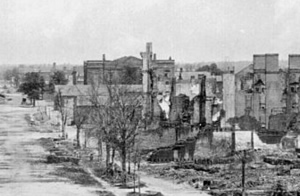This Union campaign is one of the most controversial of the Civil War because of the damage it wrought to civilian property and the questions it raised about fair play in war. Arriving at Savannah, Georgia, in December 1864, General William T. Sherman planned to advance his Union army north through the Carolinas into Virginia, where armies under Robert E. Lee and Ulysses Grant remained deadlocked in trench combat. As Sherman had done in Georgia, he also hoped in South Carolina to destroy railroads, supplies, and morale. He saw poetic justice in unleashing his forces upon the state that seceded first and had been the site of the war’s first shots. “The whole army is burning with an insatiable desire to wreak vengeance upon South Carolina,” Sherman wrote. “I almost tremble at her fate, but feel that she deserves all that seems in store for her.”
After a month’s preparation, operations began on February 1, 1865. Sherman organized his 60,079 men into left and right wings, commanded by General Henry Slocum and General Oliver Howard, respectively, and a cavalry force under General Judson Kilpatrick. The right wing (Fifteenth and Seventeenth Corps) feinted toward Charleston. The Union naval blockade and occupation of the Sea Islands had reduced the city’s usefulness as a port, but Charleston had remained a haven for blockade-runners, a munitions center, and a target of rich symbolic value. Meanwhile, the left wing of Sherman’s army (Fourteenth and Twentieth Corps) angled toward Augusta, which contained important munitions and gunpowder factories. After several days, however, Sherman brought the wings together and advanced north toward Columbia.
Confederate general P. G. T. Beauregard responded as Sherman hoped by concentrating his defenses at Charleston and Augusta. This Union deception aside, the Confederate leadership suffered from personnel shortages and disunity of command. Beauregard had twenty thousand soldiers, many of whom were poorly trained boys and old men. From Virginia, Lee sent a depleted infantry brigade under John Doby Kennedy, a Georgia cavalry brigade, and a small cavalry detachment commanded by two South Carolinians, Matthew Butler and Wade Hampton III. These officers mainly added to the confusion. The only general to successfully engage Sherman was Joseph Wheeler. On February 11 Wheeler’s cavalry achieved one of the few Confederate victories of the campaign by ambushing Kilpatrick’s cavalry at Aiken.
 Ruins of Columbia as viewed from the S.C. Statehouse. Photo by George N. Barnard, U.S. Army. See larger picture via Wikimedia. |
Few people thought that the Union army could cross the swamps and rivers that formed a natural barrier to Columbia. Winter rains made Lowcountry roads impassable. Sherman’s scouts used canoes, and his engineers navigated the obstacles with portable pontoon bridges and “corduroy roads” of logs. Despite skirmishes with Wheeler’s cavalry and occasional Confederate attempts to defend key terrain (as happened at Rivers Bridge from February 2 to February 4), the Union forces averaged almost ten miles daily. On February 15 they reached Columbia’s outskirts. Confederate forces under Hampton resisted briefly before evacuating and leaving the mayor to surrender on February 17.
That night a fire destroyed one-third of Columbia. In the accusations that followed, Sherman blamed Hampton for leaving burning cotton bales in the streets, a northern wind for helping to spread the blaze, and civilians for giving his troops alcohol. Sherman’s detractors accused him at best of failing to control his soldiers, at worst of planning arson. Vengeful former slaves and ex-Union prisoners of war held at nearby Camp Sorghum have also been named as possible culprits.
The Columbia conflagration was unusual only for its size. Barnwell, Orangeburg, and smaller places along Sherman’s thirty-mile-wide path also suffered. Railroads and anything of military value were destroyed. Residents went hungry after losing winter food supplies to foragers, both Union and Confederate. Although rape and murder were unreported, civilians endured theft of valuables, humiliation of women, and destruction of homes and private property at the hands of opportunistic Union “bummers.” After burning portions of Winnsboro, Camden, and Cheraw (Florence was spared after a successful defense on March 5 by cavalry general Beverly Robertson), Sherman ordered his army to behave less vindictively when it crossed into North Carolina at the beginning of March.
Sherman’s march embittered Southerners who believed that making war on noncombatants was dishonorable. Especially as it passed through South Carolina, the march presaged the “total war” that would become common during the twentieth century. For slaves, however, it meant freedom. Although Sherman called African Americans the “inevitable Sambo” and used his black soldiers as laborers, he did, with the approval of Secretary of War Edwin Stanton, order that the coastline and thirty miles inland from Charleston to northern Florida be reserved for former slaves, introducing the idea of “forty acres and a mule” as compensation. Sherman’s order was later overturned, but it would become the subject of still more controversy during Reconstruction.
— Excerpted from the entry by Andrew H. Myers. To read more about this or 2,000 other entries about South Carolina, check out The South Carolina Encyclopedia by USC Press. (Information used by permission.)



 We Can Do Better, South Carolina!
We Can Do Better, South Carolina!
























